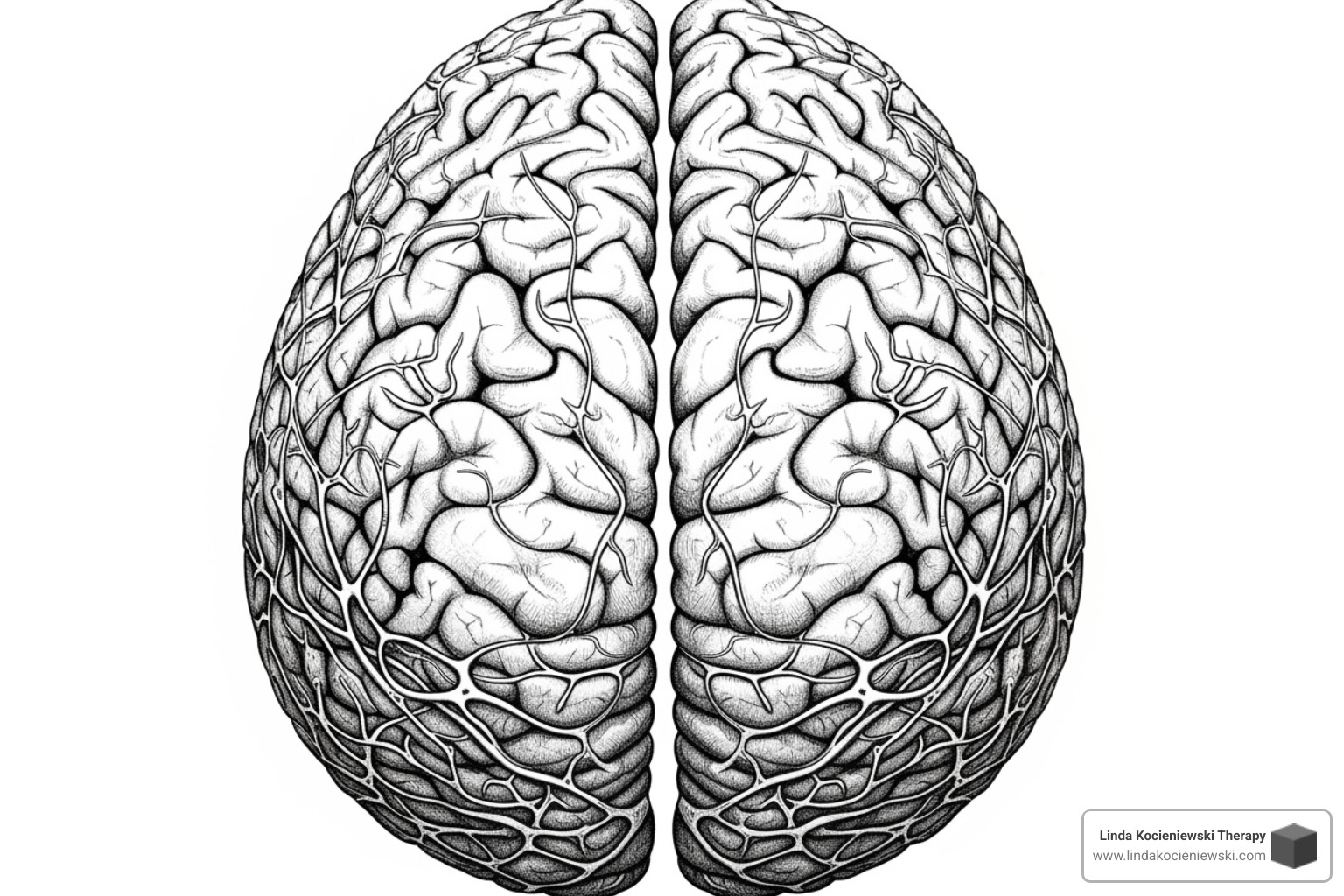Beyond the Blink: A Deep Dive into EMDR for Traumatic Memories
Understanding How EMDR Transforms Traumatic Memories

When painful memories from your past continue to intrude on your present, it can feel like living with a ghost. You might experience sudden waves of anxiety, a constant sense of being on edge, or an unexplainable sadness that colors your daily life. These are the echoes of past trauma, memories that have become "stuck" in your nervous system, preventing you from living fully. Trauma and EMDR represents a significant breakthrough in mental health, offering a structured, evidence-based path to quiet those echoes and reclaim your peace.
Endorsed by the World Health Organization and the American Psychiatric Association, Eye Movement Desensitization and Reprocessing (EMDR) is a highly effective approach for processing traumatic memories without requiring you to relive them through detailed retelling. Many people see significant improvement in a relatively short number of sessions as the therapy works with the brain's natural healing capacity to treat conditions like PTSD, anxiety, and the deep-seated effects of childhood abuse.
Your brain has an innate capacity to heal from psychological wounds, much like your body heals from physical injuries. However, the overwhelming nature of traumatic events can disrupt this process, leaving memories "stuck" and unprocessed. They remain frozen in time, causing distress long after the danger has passed. EMDR therapy helps reactivate your brain's natural healing process through a structured eight-phase approach. It doesn't erase the memory; instead, it transforms how the memory is stored, reducing its emotional charge and integrating it into your life story as a source of strength, not pain.
As Linda Kocieniewski, a Certified EMDR Therapist and EMDRIA Approved Consultant, I have witnessed many adults reclaim their lives through trauma and EMDR treatment. My specialized approach combines attachment-focused EMDR with personalized care to help you move from a life of surviving to one of thriving.
What is EMDR? Unpacking the Science Behind the Acronym

EMDR stands for Eye Movement Desensitization and Reprocessing. It was developed in 1987 by Dr. Francine Shapiro after she made the serendipitous findy that her own distressing thoughts diminished when her eyes moved rapidly back and forth. This personal insight led to the development of a structured therapy that uses Bilateral Stimulation (BLS)—such as guided eye movements, alternating auditory tones, or tactile tapping—to help the brain process and integrate difficult memories.
The core theory behind EMDR is the Adaptive Information Processing (AIP) model. This model posits that the brain has a natural, physiological system for processing life experiences and storing them in an accessible and useful form. Think of your brain as a highly efficient librarian. Every day, it takes in new experiences (books) and processes them overnight, filing them neatly on the correct shelves in your life's library. You can later access these books and recall the story, but the emotional charge is neutral. However, when an event is traumatic, it's like a flood of thousands of books being dumped on the library floor at once. The system is overwhelmed. The memory, with all its raw emotions, images, and physical sensations, gets stuck in a chaotic pile, never properly filed. These unprocessed memories can be triggered by anything in the present—a sound, a smell, a particular situation—making it feel as though the trauma is happening all over again.
EMDR helps restart this natural healing process. It's crucial to distinguish between reprocessing and reliving; the goal is never to re-experience the full force of the trauma. Instead, we allow your brain to finally store the memory in a way that it no longer has power over your present life. Scientific research on EMDR's theory continues to support its effectiveness in healing these psychological wounds.
How EMDR Works to Heal Trauma
EMDR uses a unique element called dual attention stimulation. During a session, you'll be guided to focus on a troubling memory internally while simultaneously engaging in external bilateral stimulation (eye movements, tapping, or tones). This dual focus—having one foot in the past (the memory) and one foot in the present (the safety of the therapy room and the physical sensation of BLS)—is key. It appears to activate processes similar to those in REM sleep, where the brain naturally sorts, files, and consolidates daily experiences.
This process helps reduce the vividness and emotional charge of traumatic memories. As we work together, your brain begins to create new, adaptive neural pathways. A memory where you felt helpless can finally connect with your present-day awareness of your strength and resources. The isolated, toxic memory becomes integrated into your broader life story—something that happened, but something that no longer defines you or controls your reactions.
The Role of the AIP Model
The Adaptive Information Processing (AIP) model provides a clear framework for understanding the lasting effects of trauma. Normally, your brain digests experiences, learns from them, and files them away appropriately. However, trauma disrupts this system, causing memories to be stored dysfunctionally. They remain isolated, raw, and imbued with the original emotions and sensations. This is why present-day triggers can have such a powerful and disproportionate impact, pulling you back into the past.
The goal of trauma and EMDR is to restore this natural processing ability. By using bilateral stimulation within a safe and structured protocol, we help your brain access these stuck memories and finally file them correctly. The memory is integrated with more adaptive information, such as your current safety, resilience, and strengths. This leads to a profound sense of resolution and relief, as the memory takes its rightful place in the past, allowing you to live more fully in the present.
The 8 Phases of EMDR Therapy: Your Personalized Roadmap to Healing

When you begin trauma and EMDR therapy, you start on a structured journey that is carefully personalized to your unique history and goals. The eight-phase protocol provides a safe, predictable, and effective framework for healing. Each phase is a crucial stepping stone, and we move at a pace that feels right for you, ensuring you always feel supported, prepared, and in control of your own healing process.
Phase 1: History Taking and Treatment Planning
Our work begins with a thorough and compassionate exploration of your history. This is not just about what happened to you, but also about your strengths, resources, and goals for therapy. Together, we will create a detailed treatment plan, identifying the specific memories or beliefs that are the source of your current struggles. This collaborative map ensures our work is focused and effective, targeting the roots of the problem rather than just managing symptoms.
Phase 2: Preparation and Resourcing
This is perhaps the most critical phase, especially for those with complex or developmental trauma. We do not rush into processing. Instead, we build a robust 'toolkit' of coping skills to ensure you can regulate your nervous system and feel safe throughout the therapy. We will collaboratively develop your internal resources, which may include:
- The Calm/Safe Place Exercise: A guided visualization to create a detailed sanctuary in your mind that you can access anytime you feel distressed.
- The Container Exercise: A technique to mentally 'contain' or store distressing thoughts and memories between sessions, giving you control over when you engage with them.
- Resource Figures: Identifying and imagining supportive figures (real or imagined, past or present) who can offer you strength and wisdom. This phase builds the essential foundation of safety and stability needed for the deeper work ahead.
Phases 3-6: Actively Processing the Memory
Once a strong foundation is established, we move to the active reprocessing phases.
- Phase 3 (Assessment): We activate the target memory by identifying its key components: the image, the associated negative belief about yourself (e.g., "I am not safe"), and a desired positive belief (e.g., "I am safe now"). We use scales like the Subjective Units of Disturbance (SUD) and Validity of Cognition (VoC) to measure the memory's current impact.
- Phase 4 (Desensitization): While you hold the memory in mind, we begin short sets of bilateral stimulation. You are not asked to talk through the memory; you simply notice what comes up. After each set, I will ask, "What do you notice now?" Your role is to observe your internal experience without judgment. This is your brain's natural healing process at work, creating new, adaptive links.
- Phase 5 (Installation): Once the memory's emotional charge has dropped, we work to strengthen and install the positive belief, using BLS to help your brain fully integrate this new, healthier perspective.
- Phase 6 (Body Scan): Trauma is held in the body. We scan your body for any residual physical tension or discomfort associated with the memory and use BLS to process it until your body feels calm and clear.
Phases 7 & 8: Integration and Looking Forward
- Phase 7 (Closure): Every session ends with you feeling calm, grounded, and in control. If a memory is not fully processed, we use the containment techniques learned in Phase 2 to ensure you feel stable and can comfortably go about your week.
- Phase 8 (Re-evaluation): At the start of each new session, we check your progress, ensuring that previously processed memories remain neutral and that positive beliefs feel strong. This phase also involves preparing you to apply your new skills and resilience to future situations, helping you move forward with confidence and strength.
Who Can Benefit? Exploring the Applications of Trauma and EMDR

Trauma and EMDR therapy is designed for adults who are ready to engage in deep, transformative work. It is particularly powerful for those who feel "stuck" in patterns of anxiety, depression, or self-doubt and are seeking to address the root causes of their struggles. If you find yourself held back by past experiences or limiting self-beliefs, EMDR can help change how those memories are stored in your brain, freeing you to live more fully and authentically in the present.
Conditions Treated with EMDR
While renowned for treating Post-Traumatic Stress Disorder (PTSD), EMDR's applications are broad because it addresses the underlying memories that fuel many kinds of emotional distress.
- PTSD and Complex PTSD (C-PTSD): Highly effective for single-event trauma and expertly adapted for the challenges of prolonged or repeated traumatic experiences from childhood or adulthood.
- Anxiety and Depression: Helps reprocess the past experiences, losses, and negative beliefs that often form the foundation of anxiety disorders and depressive symptoms.
- Phobias and Complicated Grief: Can desensitize the fear response to specific triggers (like fear of flying or public speaking) and help process the traumatic aspects of a profound loss.
- Childhood Abuse and Neglect: Addresses deep, early wounds that impact adult relationships, self-esteem, and emotional regulation, making it invaluable for healing developmental trauma.
- Performance Anxiety: Helps reprocess past experiences of failure, criticism, or humiliation that may be affecting your professional, athletic, or creative life.
Is EMDR an Effective Therapy for Trauma?
Yes, the evidence supporting EMDR is extensive and robust. It is an empirically validated, evidence-based practice with decades of research behind it. More than 30 controlled outcome studies have demonstrated its effectiveness, leading to endorsements from major health organizations worldwide.
The American Psychiatric Association, the World Health Organization (WHO), and the U.S. Department of Veterans Affairs all recognize EMDR as a first-line, effective treatment for trauma. This global consensus is based on rigorous scientific trials that show lasting results. For many, especially those with single-incident trauma, the results can be both rapid and permanent, as EMDR fundamentally transforms how the brain stores and relates to traumatic memories.
Treating Complex Trauma (C-PTSD) with EMDR
Complex PTSD, often resulting from prolonged or repetitive trauma like childhood abuse or domestic violence, requires a specialized and nuanced treatment approach. It can deeply affect emotional regulation, relationships, and core beliefs about oneself and the world. Treating C-PTSD with trauma and EMDR requires a carefully customized and paced approach that prioritizes safety above all.
The preparation and resourcing phase is crucial and often extended. We spend significant time building your internal resources and establishing a strong foundation of safety and nervous system regulation. My attachment-focused EMDR approach is particularly suited for C-PTSD, as it directly addresses how early trauma affects your sense of self and your ability to form secure, healthy relationships. We work collaboratively, always prioritizing your stability and moving at a pace that feels manageable. While the process may be longer than for single-incident trauma, the deep, lasting changes can be truly life-altering.
EMDR in Practice: What to Expect and How It Differs

Stepping into EMDR therapy is a unique healing experience that honors the profound connection between your mind and body. The process is intentionally designed to create rapid and lasting shifts in how you relate to your past, setting it apart from other forms of therapy.
How EMDR Differs from Traditional Talk Therapy
Many clients wonder how EMDR is different from the talk therapy they may have experienced before. While both are valuable, their approach and mechanisms differ significantly.
- Focus of Processing: Traditional talk therapy relies on verbal exploration. You discuss events, analyze your thoughts, and gain cognitive insight. EMDR, while it involves talking, centers the healing on internal, somatic experience. The primary work happens during the silent, internal processing guided by bilateral stimulation.
- Role of the Traumatic Memory: In talk therapy, you might recount the traumatic story in detail to gain perspective. In EMDR, you do not need to provide a detailed, linear narrative. The goal is not to talk about the memory, but to allow the brain to reprocess it.
- Mind vs. Mind-Body: Talk therapy often focuses on changing thought patterns (the mind). EMDR is inherently a mind-body approach. It recognizes that trauma is stored physically in the nervous system and uses the Body Scan phase to ensure that physical tension associated with the memory is released.
- Homework: Talk therapy may involve journaling or thought records. EMDR has no formal homework, as the brain continues to process and integrate the work naturally between sessions.
Key Features of the EMDR Process
- Focus on Internal Experience: EMDR facilitates healing without requiring you to describe traumatic events in extensive detail. The focus is on your internal experience—the emotions, images, and body sensations that arise as your brain makes new, healing connections.
- Body-Based Healing: A core component of EMDR is its focus on the body. Recognizing that trauma is held in the nervous system, we regularly check in on physical sensations, as releasing stored tension is a vital part of the healing process.
- Efficient and Lasting Results: EMDR is known for its efficiency. By working directly with the brain's natural processing mechanisms, it can produce significant and durable changes, often more rapidly than traditional therapeutic approaches.
- Personalized and Structured: While EMDR follows a structured eight-phase protocol, every aspect is personalized. We adjust the pace, the type of bilateral stimulation, and the targets based on your unique history, goals, and nervous system responses.
Understanding the Timeline for Trauma and EMDR Treatment
While every healing journey is unique, we can outline a general timeline. Sessions typically run 60 to 90 minutes to allow for thorough processing.
For single-incident trauma, many people experience significant resolution within 6 to 12 sessions. For complex and developmental trauma, treatment naturally requires more time. We focus on building robust internal resources before processing layers of experience, honoring the complexity of what you've survived.
For those seeking more concentrated healing, EMDR Intensives are also an option. These extended sessions (e.g., half-day or full-day sessions over several consecutive days) can facilitate significant breakthroughs in a shorter overall timeframe. During our initial consultation, we will discuss your goals and create a treatment plan that honors your needs.
Frequently Asked Questions about EMDR
It's natural to have questions when considering a unique and powerful approach like trauma and EMDR therapy. Here are answers to some of the most common questions I hear from clients.
Is EMDR therapy controversial?
When EMDR first emerged, there was some debate in the scientific community about why it worked so well. However, over the past three decades, extensive research has definitively validated its effectiveness. With more than 30 positive controlled outcome studies, EMDR is now firmly established as a credible, evidence-based, first-line trauma treatment. It is endorsed by the American Psychiatric Association, the World Health Organization, and other major health bodies worldwide, resolving any early controversy with decades of proven results.
Will I lose control or be hypnotized?
This is a common and understandable concern. Let me be clear: EMDR is not hypnosis. You remain fully awake, alert, and in control throughout the entire session. You are an active participant in your healing, and we establish a "stop" signal that you can use at any time for any reason. My role is to be your guide and to create a safe container for your process. The ultimate goal of trauma and EMDR is to restore your sense of control over your life, not take it away.
What if I can't remember the details of my trauma?
Detailed memory recall is not required for EMDR to be effective. Trauma is often stored in fragments—images, feelings, beliefs, or body sensations—rather than a clear, linear narrative. EMDR works with whatever you bring to the session. It accesses both explicit (conscious) and implicit (unconscious, body-based) memory. Your brain's natural healing system will guide the process, bringing forward what is ready to be healed, even if your conscious mind isn't sure of the details.
Will EMDR erase my memories?
No, and this is a crucial point. EMDR does not erase memories. Your life story remains intact. What it does is remove the painful emotional and physical charge associated with the memory. Imagine a memory that is currently 'hot' to the touch—painful to think about. After EMDR, that same memory becomes 'cool' or neutral. You can remember what happened without being overwhelmed by the original terror, helplessness, or pain. The memory is integrated as a fact from your past, rather than a wound that is still open in the present.
How will I feel after an EMDR session?
Responses vary from person to person and session to session. Many people report feeling a sense of calm, lightness, or relief immediately following a session. Because the brain has done significant work, it's also common to feel tired, similar to how you might feel after a strenuous physical workout. For 24-48 hours after a session, your brain may continue to process the material. You might have new insights, unusual dreams, or feel more emotional. This is a normal part of the integration process, and we discuss self-care strategies to support you during this time.
Is EMDR only for 'big T' Trauma?
EMDR is highly effective for what is known as 'Big T' trauma—life-threatening events like combat, natural disasters, or severe assault. However, it is equally effective for 'small t' traumas. These are deeply distressing life events that may not be life-threatening but exceed a person's capacity to cope, leaving a lasting negative impact on their self-perception and worldview. Examples of 'small t' trauma include childhood emotional neglect, persistent bullying, a humiliating experience at work, or a painful breakup. These experiences can create the same kind of 'stuck' memories and negative self-beliefs that EMDR is designed to heal.
Conclusion: Take the First Step Towards a New Beginning
We've explored the comprehensive landscape of trauma and EMDR, a therapy that offers a profound and evidence-based path to healing. By leveraging the brain's own Adaptive Information Processing system through bilateral stimulation, this therapy helps you finally file away 'stuck' memories. It transforms painful experiences from raw, open wounds into integrated parts of your history—sources of strength and resilience, not pain.
The eight-phase protocol ensures your journey is safe, thorough, and carefully personalized to your unique needs and history. Whether you are dealing with a single traumatic event, the pervasive effects of complex childhood trauma, or performance blocks that hold you back, EMDR offers a powerful and efficient pathway to lasting change. You remain in control throughout the process, and detailed memory recall is not necessary for deep healing to occur.
For adults in Midtown, NYC and throughout New York State who are ready to move from surviving to thriving, my attachment-focused EMDR approach offers hope for profound and lasting change. I have witnessed countless individuals reclaim their lives, finding that healing is not just possible—it's within reach.
The journey of a thousand miles begins with a single step. If you're ready to explore how trauma and EMDR can help you move toward a happier, healthier, and more authentic life, I invite you to schedule your complimentary Zoom consultation today. We'll discuss how I can best help you and what you hope to gain from therapy. For additional information and resources, you can also visit the EMDR International Association at EMDRIA.org.